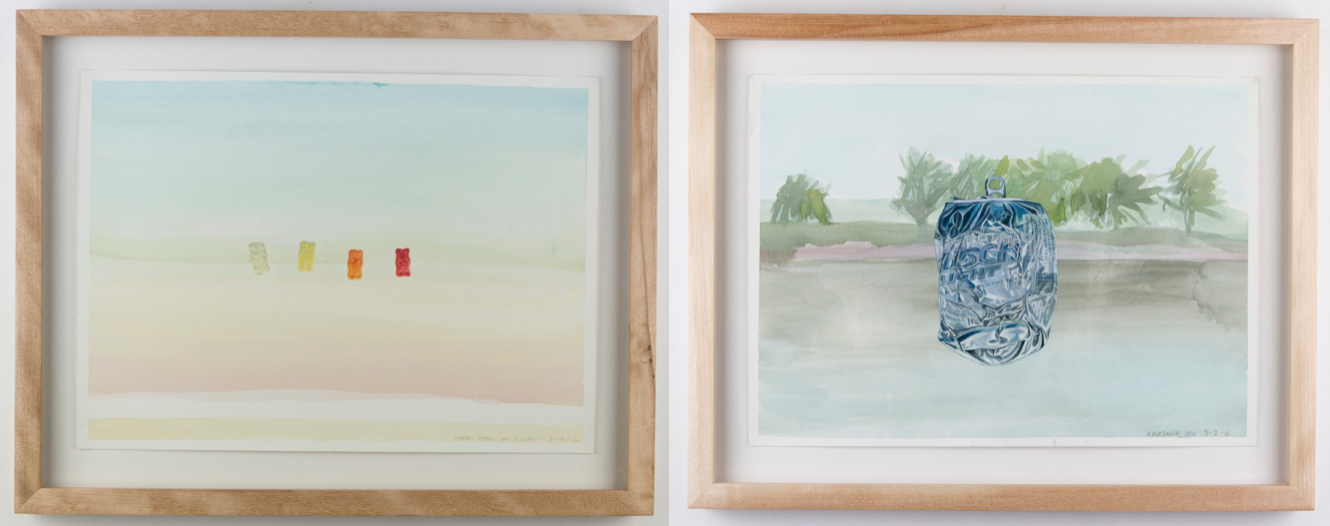Conscious Reverie
Conscious Reverie: Cynthia Bjorn’s Story In Color
The collection of works displayed in Cynthia Bjorn’s solo exhibition Story In Color offer us an intimate glimpse into her evolution as a person and an artist. In a culture currently consumed with self-care and wellness it can be easy to scoff at the notion of presence but Bjorn’s utter lack of pretense makes engaging with her dialogue fluid. Her current practice has veered away from the aggressive action and large gestures of her older works and into new territory. Bjorn likens the changes in her aesthetic to her own life and a realization that her practice could be used to self direct her thoughts and feelings. The staccato energy of her former creative angst has simmered into a mindful legato intent on conscious reverie. Much like her work, Bjorn herself has a bright and steady energy and with this energy she has blended mark making and color into personal meditations.
Left, right : Grey 12 , Grey 13, Metallic Buzz, Bendable, Lime 11, acrylic on panel with resin - 12/24/12/36/12 X 36
Gratitude, acrylic on panel with resin,104x24 + detail
The long, feathery brushstrokes Bjorn’s current work has become known for are the result of expertly blended paint and a still hand. Bjorn uses acrylic paint mixed with medium to create the proper consistency needed for the thousands upon thousands of fine lines in her subtly detailed, minimal pieces. Each line is made with purpose and intention, and each set of colors is a reflection of Bjorn’s spiritual interior. At a distance her works communicate oscillating colors and an organic hatching, but up close her paintings give way to much more. Dense layers reveal themselves in fragments, nuanced colors emerge as fine lines momentarily cross paths, and the rich coating of resin cascading across the surface of the panel becomes more than just sheen. The resin Bjorn applies to each of her paintings captures a fantastic dynamism that allows the deepest layers to peak out as the top layer tucks in. The meditation that Bjorn brings into her mark making is matched by the meditative headspace required for the precision of her resin work: both meditations are frozen in time as the resin tightly glosses the panel before curing in sterile isolation. Once the panels have fully dried they emerge from their studio quarantine imbued with Bjorn’s energy.
Bjorn’s panels each carry their own emotional weight, but their mutual dimensions allow the pieces to be arranged in family units that create their own narratives. With each panel sharing the same measured length alongside differing widths they cluster and pair together in seemingly endless conversation. A trio of deep gray and black pieces partner with a pair of citrusy lime panels creating a vision of a somber mood turned hopeful. This group of panels is a reminder that a bad morning hasn’t stolen the day and that sometimes the best we can do is surrender. A stack of panels in deep neutral tones titled Gratitude appears almost figurative and deeply grounded in the Earth: the steady energy of Bjorn’s gratefulness buzzes lightly beneath the luster of each piece.
Left: Be Still, acrylic on panel with resin, 24 x 36 Right: Underfoot, acrylic on panel with resin, 36 x 36
A panel dressed in a lattice of chilly blues and creams atop a base of rich grey feels like a crisp inhale while a mossy green panel ebbs and flows in its verdancy like a nice deep exhale. A family of panels in rosy pinks and peachy tones elicits the warm energy of a hug or the deep breath needed to conjure hope. This color family is unified by a thin web of shimmering gold lines resting upon the surface as a sort of suture or embrace. The largest piece in this family is titled Talking to Angels and the smallest is the aptly named Mother’s Song — the details of Bjorn’s meditations remain private, but these panels seem to invite viewers to experience a sense of both loss and hope.
Left: Talking to Angels, acrylic on panel with resin, 36x36 Right: Mother’s Song, acrylic on panel with resin, 24x36
Like people, each of Bjorn’s paintings has a story to tell within a malleable context. Just as our own lives are temporary and often provisional, every panel’s color and every collection of panels evokes a new story. We may have said so long to Story In Color, but it’s certainly not goodbye. Bjorn’s pieces will continue to have presence in the Weinberger Fine Art main space. We invite you to come take a look and experience your own color story by appointment or by chance.















